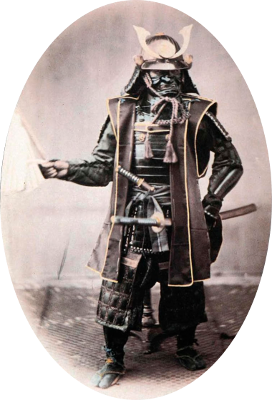![]() The Pacific War Online Encyclopedia
The Pacific War Online Encyclopedia
|
| Table of Contents |

The Japanese Army tried to compensate for material deficiencies
with fighting spirit. Following the Takebashi Mutiny of 23 August
1878, the Army high command began inculcating soldiers with bushido ("the way of the
warrior") as a way to improve discipline. This trend continued
after the Russo-Japanese War of 1905, when at least one body of
Japanese troops had to be driven forward to battle at bayonet point.
Corporal punishment, already practiced informally, became
institutionalized as part of the squad
regulations of 1908. In June 1879 the Shōkonsha memorial to the dead of the Boshin
Civil War was converted to the Yasukuni Shrine, dedicated to the
uniqueness of the Japanese people and the divinity of the Emperor under state Shintō. Soldiers who
fell heroically in battle were acclaimed as "war gods" (kami).
Bushido was promulgated as the ancient Japanese samurai's code of chivalry,
but there are few references to it prior to the 20th century, and
Professor Hall Chamberlain wrote in 1912 that "Bushido, as an
institution or a code of rules, has never existed. The accounts
given of it have been fabricated out of whole cloth, chiefly for
foreign consumption.... Bushido was unknown until a decade or so
ago" (quoted in Johnson 1983). It was popularized by a samurai
professor, Inazo Notobe, in 1907, who defined bushido as
"to be contented with one's position in life, to accept the natal
irreversible status and to cultivate oneself within that allotted
station, to be loyal to the master of the family, to value one's
ancestors, to train oneself in the military arts by cultivation
and by discipline of one's mind and body" (ibid.)
Emperor worship became an important element of Army discipline.
The Imperial Rescript to the Armed Forces declared that
orders from a superior officer were to be regarded as from the
Emperor himself. This was considered awkward enough in certain
situations that the Japanese word for "notification" was used
instead of the word for "order". For example, instructions on comfort women, or on
euthanasia of wounded
soldiers who could not be evacuated, were couched as
"notifications" rather than "orders". This avoided the implication
that military prostitution or euthanasia were the will of the
Emperor himself.
All these measures had a dark side that was manifest in a
shocking record of atrocities
committed throughout the Pacific and east Asia. Drea (2009) has
described the transformation of the Army from a force noted for
its good conduct in the Russo-Japanese War and First World War to
the force noted for its brutality in the Second World War as a
"sea change." Tillman (2010) has suggested that the decline of
Buddhism and Confucianism in the face of state Shintō
removed an important moderating element from Bushido.
References Cook and Cook (1992)
Evans and
Peattie (1997)
Hoyt (1993)
The Pacific War Online Encyclopedia © 2018 by Kent G. Budge. Index